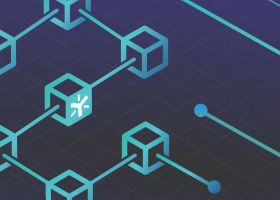Cyber Security for Finance
Let’s jump in and learn:
- What Is Cyber Security in Finance?
- What Makes Cyber Security Challenging within the Financial Services Field?
- What Are the Three Major Types of Cyber Security?
- The Six Biggest Cyber Threats for Financial Services in 2023
- Cybersecurity Solutions for the Financial Services Industry
- Digital-First Banking Drives Need for Increased Cyber Security in Banking
What Is Cyber Security in Finance?
Cyber security for finance focuses on protecting system components (e.g., computers, servers, mobile devices, applications, networks, and data) from unauthorized exposure and attacks. The collection of financial data protection solutions that make up cyber security for finance includes tools that guard against a variety of threats, such as attacks, accidental damage, malware, viruses, hacking, data theft, and ransomware.
Examples of cyber security for finance include the following.
Account and password management
Ensure that the passwords used are strong to make them secure, not easily guessed, updated regularly, and never set as temporary or default.
Decommissioning access
To physical and digital infrastructure for employees and third parties when it is no longer needed.
Disaster recovery plans
Include a process for creating a retrievable backup and archival copies of critical information as well as plans for reestablishing operations and remediating any damage and the root cause.
Compliance assessments
Include regular reviews of which individuals have access to sensitive facilities, systems, or information systems and whether that access is still required.
Confidentiality of sensitive data and system management
procedures include protecting and disposing of hardware and electronic media used to store sensitive information.
Physical security
Is often overlooked, but it is important to protect access to physical infrastructure with special attention paid to employees’ workstations and connected devices (e.g., printers, smart screens, security cameras).
Training
Makes sure that employees understand the importance of security and how to maintain it, including proper methods for managing personally identifiable information (PII) (e.g., social security numbers, names, addresses, and phone numbers).

The importance of cyber security for finance can not be underestimated, as banks must protect not just the assets they hold, but the billions of transactions they handle every day. Following are several commonly cited reasons why cyber security for finance should be a top priority, including the following:
Digitization of transactions
With most of banks’ transactions moving to digital, their attack surfaces have grown exponentially. In addition to protecting its physical and digital locations, banks must shore up protections for transactions, which are more susceptible to attacks.
Reputation and customer loss
While it is very difficult to steal funds from a bank, attacks more often target customer data which is more accessible. Theft of customers’ data is upsetting and leads to customers closing their accounts for fear of what could come next and an overall demise in the bank’s reputation amongst consumers and the industry. Therefore, the financial impact of the loss of customer data can be as significant as the theft of assets.
What Makes Cyber Security Challenging within the Financial Services Field?
Among the many challenges facing financial services organizations despite the availability of cyber security for finance are:
- Exploitation of personal information shared on social media for password attacks
- Increase in ransomware
- Lack of knowledgeable IT security professionals
- Limited security budgets to meet the growing need for more support
- Migration to multi-cloud has expanded attack surfaces and increased complexity
- Poor management of identities and access
- Proliferation of connected devices (e.g., personal devices, IoT devices)
What Are the Three Major Types of Cyber Security?
The major types of cyber security for finance are application security, cloud security, and network security are:
Application cyber security for finance
As the name implies, application cyber security for finance offers safeguards for applications. The National Institute of Science and Technology (NIST) describes application security as “a safeguard or countermeasure prescribed for an information system or an organization designed to protect the confidentiality, integrity, and availability of its information and to meet a set of defined security requirements.”
Among the functionality provided by the application cyber security for finance are features that prevent cyberattacks, such as malware or bot attacks. Application security also can stop malicious interactions with an organization’s applications and APIs by using software, hardware, and a combination of proven processes.
These application cyber security for finance approaches are designed to bring automation to a number of application security functions, such as authentication, authorization, availability, confidentiality, and integrity of deployed applications. This function also brings application cyber security for finance into the development process with testing tools and best practices.
Cloud cyber security for finance
With the cloud becoming a key part of financial institution’s IT infrastructure, cloud cyber security for finance has also come to the fore with solutions to secure data, applications, or services housed on these systems. An effective cloud cyber security for finance strategy includes controls and services designed specifically to protect an organization’s cloud infrastructure with physical security, logical security, and operational security.
Cloud cyber security for finance covers detection, exposure management, prevention controls, response, and visibility. Included in cloud security are business continuity (BC) planning, data retention (DR), data security, identity and access management (IAM), governance (i.e., policies for threat prevention, detection, and mitigation), and compliance management.
Network cyber security for finance
Networks are the most targeted attack vectors and should be treated as the most important. Network cyber security for finance protections should be based on a strategy that includes automated security and response orchestration (SOAR), network analysis, threat hunting, and enforcing safe web policies.
Among the many tools used for network cyber security for finance are firewalls, intrusion detection systems (IDS), and anti-virus software. Firewalls are designed to stop unauthorized network access by inspecting all traffic in and out of the network and blocking anything deemed anomalous. Intrusion detection systems are designed to detect unauthorized activity by monitoring all traffic to identify patterns that indicate malicious activity.
Anti-virus software is designed to defend against malware and other viruses by scanning all inbound and outbound files for signs of infection. In addition to these, network cyber security for finance best practices include backing up encrypting and data, conducting frequent network audits to check security controls, and reviewing communicating security policies.
Three other types of cyber security for finance to consider are the following:
Internet-of-things (IoT) cyber security for finance
The number of IoT devices in organizations has exploded. While these connected devices offer many benefits, they are also highly risky. IoT devices are often running on internal networks without authorization or oversight by IT and security teams.
Due to the nature and volume of IoT devices, their security leaves much to be desired—infrequently, if ever, having patches installed and running with little to no security protections—making them a target for cyber attackers seeking a point of entry. This has raised awareness of and increased the need for IoT cyber security for finance.
Mobile cyber security for finance
Nearly every person who connects to an organization’s network does so with at least one mobile device. Each of these mobile devices brings an additional potential point of attack to be exploited. Mobile cyber security for finance focuses on this attack vector bringing purpose-built protections to harden these devices and their connections.
The Six Biggest Cyber Threats for Financial Services in 2023
When considering cyber security for finance, it is important to understand the threat landscape. The following are six of the biggest threats that cyber security for finance aims to defend against.
1. Cloud-based attacks
Many finance organizations store, process, and share data using cloud services. This has caused an increase in cloud-based attacks. Among the many that cyber security for finance protects against are the following:
Cloud malware injection attacks
With cloud malware injection attacks, malicious code, such as viruses or ransomware, is injected into cloud computing resources or infrastructure. This provides a point of entry for an attacker to compromise the affected cloud systems—stealing data or using the resources for their purposes.
Attackers can inject malware into cloud resources in several ways, including:
- Adding a malicious service module to a SaaS or PaaS system
- Exploiting vulnerabilities in the cloud infrastructure or the systems and applications running on the cloud
- Gaining unauthorized access to cloud accounts and injecting malware
- Infecting an IaaS system’s virtual machine and diverting user traffic to it
Cookie poisoning
In the context of cloud applications, cookie poisoning is the unauthorized modification or injection of malicious content into a cookie. Small pieces of data stored on users’ computers by a website or web application, cookies are pervasive and provide an expansive attack surface as attackers can use them to access cloud applications.
Insecure cloud APIs
Attackers exploit vulnerabilities in cloud APIs to gain unauthorized access to systems or data or to disrupt the operation of the API. For example, shadow APIs or APIs that are not documented or authorized are vulnerable to injection attacks if they are not properly validated and sanitized.
Side-channel attacks
Cloud deployments can be compromised by side-channel attacks that exploit information leaked through a system’s physical implementation, such as details about how the system is implemented or the data being processed by the system. Side-channel cloud attacks are executed by placing a malicious virtual machine on a legitimate physical host used by the cloud customer, giving the attacker access to the targeted machine. This can be used to exfiltrate data, disrupt the operation of a system, or manipulate its behavior.
2. Cyberattacks
There are many types of cyber attacks used to compromise cloud systems. Following are a few examples:
Distributed denial-of-service (DDoS) attacks
The objective of DDoS attacks is to crash target servers, websites, or networks by overloading them with meaningless traffic. This makes these inaccessible to users and makes the targets more susceptible to other attacks.
Man-in-the-middle (MITM) attacks
With man-in-the-middle attacks, attackers insert themselves into an information relay process, such as a device connecting to a network or a user logging into an account. From their position, attackers can access the data being passed and even further infiltrate the device, network, and the other systems linked to them.
Password attacks
A password attack is gaining access to a user’s password without their consent. Several commonly used password attack tactics are:
- Keyloggers and other spyware
- Password databases with weak security
- Password-generation programs
- Spying on someone as they enter their password—physically or virtually
- Using brute force, making guesses based on publicly available information, such as that commonly shared on social media (e.g., birthday, initials, favorite fictional characters, food preferences, locations)
SQL injection
A piece of malicious code can be added via a website search box using a SQL injection. This can then be used to force the server to give attackers access to sensitive information that can be exfiltrated, modified, or destroyed.
3. Malware
Malware is cyber attack software that is specifically designed to help attackers gain unauthorized access. Among the many different types of malware are:
- Botnet software, which is short for “robot network,” is a network of computers infected by malware that is under the control of a single attacking group. Each individual machine is infected, but the bots use so little processing power that they often go undetected. Botnets are used to engage in all manner of nefarious activity, including click fraud campaigns, to send spam emails, and generate malicious traffic for distributed denial-of-service (DDoS) attacks.
- Ransomware encrypts data and renders systems inaccessible. Attackers threaten to expose data to the public or destroy it unless a ransom is paid.
- Remote access trojans (RATs) infiltrate a system through a covertly installed backdoor, allowing attackers to control infected systems completely.
- Trojan malware is downloaded onto a computer disguised as a legitimate program. Once installed on victims’ systems, the trojan malware tries to gain access to internal resources.
- Viruses and worms are self-replicating malware that infects one system and then move on to infect those connected to it. The difference is that a virus needs a host program or file, and a worm does not.
4. Social Engineering
Social engineering is a type of cyber attack that uses manipulation and deceit of individuals to gain unauthorized access to systems, networks, and information. It relies on the weakest link in any organization’s cyber security for finance system—people. Phishing is one of the most effective types of social engineering to bypass cyber security for finance. With phishing, cyber attackers email fake messages that entice users to provide login credentials willingly or to trick them into opening a malicious link with malware.
5. Spoofing
Spoofing is a technique used to get around cyber security for finance where a cybercriminal disguises themselves as a known or trusted source. Examples of spoofing are DNS Spoofing, GPS spoofing, IP spoofing, spoofed calls, and spoofed emails. In the case of website spoofing, a clone site is created to mimic a financial website and used to steal confidential information.
6. Third-party threats
In the realm of cyber security for finance, third-party threats are one of the most challenging, because financial institutions rely on external relationships. The issue is that many of these third parties have access to internal systems but do not follow the same cyber security for finance protocols as the organization, which creates significant security gaps. Two of the biggest issues are the risk of exposing sensitive data and regulatory compliance violations.
Cybersecurity Solutions for the Financial Services Industry
There are many types of cyber security for finance solutions. Following are a few of the ones that most finance organizations include in their cyber security for finance mix.
- Cybersecurity training and awareness
- Anti-malware and anti-virus protection
- Data governance
- Data loss protection (DLP)
- Encryption
- Endpoint protection
- Firewalls
- Intrusion detection systems (IDS)
- Intrusion prevention systems (IPS)
- Logging and auditing
- Multi-factor authentication
- Network monitoring
- Network access controls
- Risk management
- Role-based access controls
Digital-First Banking Drives Need for Increased Cyber Security in Banking
The banking and financial sector has been transformed by digital first. The results are undeniable. Organizations that have embraced it have seen a significant increase in customer growth. It has become clear that moving to a highly-effective and lucrative customer-first requires the move to digital first.
However, digital-first brings with it untold digital risk. As cyberattacks against banks continue to escalate, criminals take advantage of the exponential increase in vulnerabilities.
A proactive protection approach requires banks to evaluate and improve their cyber security continuously. The good news is that many approaches and proven cyber security for banking provide safeguards against and tools to combat malicious and unintentional threats.
Egnyte has experts ready to answer your questions. For more than a decade, Egnyte has helped more than 16,000 customers with millions of customers worldwide.
Last Updated: 12th October, 2023

